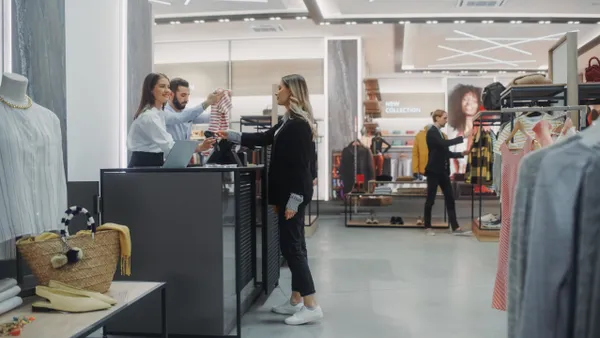Dive Brief:
- Almost three-quarters of consumers, 72%, prefer video to text for receiving branded marketing information, according to a HubSpot Research study cited in a report by Coresight Research.
- This draws a huge audience, with 65.1% of internet users across the globe viewing online video in 2017, according to an eMarketer report mentioned in the Coresight report, which also cited a Hubspot finding that video content is most memorable to 43% of consumers.
- Based on Cisco data, Coresight estimates a 29% compound annual growth rate for consumer Internet video from 2017 to 2021.
Dive Insight:
Coresight concluded that video is "convenient and effective" for brands trying to connect with consumers on the internet as video becomes the principal means by which consumers browse the internet.
Shoppable videos send consumers to links with additional information about featured items or pages where they can buy the product. Coresight said shoppable videos have become more popular because of faster Internet connections and larger mobile device screens that make the videos an easy way to explore content.
The fast-growing channel of shoppable video technology can be a powerful marketing tool for product and retail brands. Investment in the production of digital videos totaled $135 billion in 2017, according to video production firm Magisto. Among the fashion brands that are now involved in shoppable video technology are Burberry, Ted Baker and Sandro. Firms offering this video tech include Smartzer, Wirewax, Cinematique and Vue.ai.
There's room for expansion in the shoppable video space, Karoline Gross, founder and chief executive officer of Smartzer, told Coresight. While most brands that participate online or in social media have video content, few have embraced shoppable video technology. Simplicity is the primary competitive advantage with these videos, as it is a relatively easy technology that improves the online shopping experience, Gross said.
"Shoppable videos help to increase traffic and to generate revenue," Gross said. For example, Smartzer's customers saw consumer interaction increase an average of 51.4%, clickthroughs to the product detail page rise 10.6%, video completion rates of 22.5%, and sales conversions rise by 500%, she added.
Online video in general is becoming a battle ground for tech titans, which could have implications for retail. Google and Amazon are duking it out for video content as they develop their voice technology platforms. Google recently said it is adding YouTube and YouTube TV capability to Google Home and is withholding that content it from all Amazon platforms. Apart from this battle of the giants, Quiddity, a product review site launched by ad agency Figiulo & Partners, is going after Consumer Reports and The New York Times by targeting millennials with video reviews by consumers who own the products.












